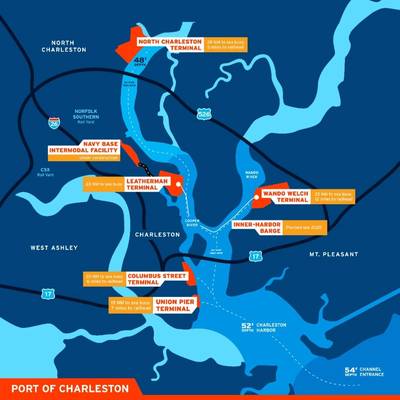Charleston has Deepest Harbor on US East Coast
Charleston Harbor is now the deepest harbor on the East Coast at 52 feet.
At 52 feet, the biggest ships calling the East Coast can access South Carolina Ports’ terminals any time, any tide. Ships filled with record imports and heavy exports can seamlessly sail through Charleston Harbor to SC Ports’ terminals.
This depth makes SC Ports more competitive, helping to attract new ship services, first-in-calls and more cargo to South Carolina.
Governor Henry McMaster and other state elected leaders, Congressional Members, project partners, business and maritime community leaders, and SC Ports officials gathered to mark the successful completion of the project.
The deepened harbor will support South Carolina’s economy and Southeast supply chains.
“It is a truly historical moment to be celebrating this monumental achievement. Charleston Harbor has been deepened to 52 feet,” SC Ports President and CEO Barbara Melvin said to cheers. “With the deepest harbor on the East Coast, we can efficiently work mega container ships at any tide. This investment will bring economic success to South Carolina for generations to come.”
South Carolina Ports and the U.S. Army Corps of Engineers, Charleston District partnered on the Charleston Harbor Deepening Project. The roughly $580 million infrastructure project was fully funded by state and federal dollars.
Deepening work began in 2018, thanks to $300 million the state set aside in 2012, followed by several infusions of federal funding. In 2019, Congress appropriated $138 million for the project, funding it to completion.
The Army Corps awarded five dredging contracts — three to Great Lakes Dredge and Dock Corp., one to Norfolk Dredging Co. and one to Marinex Construction Inc. — and the work was completed in four years.
Deepening began in the entrance channel and continued through the harbor up to SC Ports’ three container terminals.
The entrance channel was deepened to 54 feet to seamlessly handle vessels coming and going to SC Ports. A 52-foot depth was achieved in Charleston Harbor up to both Wando Welch Terminal and Leatherman Terminal, and a 48-foot depth was achieved between Leatherman Terminal and North Charleston Terminal.
Turning basins were also widened in front of Wando Welch Terminal and Leatherman Terminal, enabling ships to easily pass one another and turn around without restrictions.
With the deepening project complete, SC Ports can handle the record cargo volumes and mega container ships calling on the Port of Charleston today and in the future.
“Our deepening project was completed faster than any other project of its kind in the nation. It required tremendous dedication, collaboration and creativity from everyone involved over the past decade,” Melvin said. “We had an amazing project partner — the U.S. Army Corps of Engineers, Charleston District — as well as the dredging companies, environmental groups and business partners who worked alongside us. Thank you to Governor Henry McMaster, the SC Legislature, our Congressional delegation and the Obama and Trump Administrations for fully funding this transformational project.”
“On behalf of the board, I want to congratulate the entire SC Ports team and all our project partners on successfully deepening Charleston Harbor to 52 feet,” SC Ports Board Chairman Bill Stern said. “The deepening project took years of effort, planning and collaboration. It would not have happened without the support of Governor Henry McMaster, the SC Legislature and our Congressional delegation. Thank you to everyone who worked to make this successful, ensuring we will remain a top 10 U.S. container port.”
“Many great things come from humble beginnings, and Charleston Harbor is no exception,” said Lt. Col. Andrew Johannes, USACE, Charleston District, District Engineer and Commanding Officer. “In 1760, during the age of sail, the harbor averaged a depth of only 12 feet. Nearly 100 years later, in 1851, the harbor underwent its first deepening to 17 feet to accommodate larger, heavier steam vessels and the World’s first hydraulic dredge, the General Moultrie, was employed. Today, the Army Corps of Engineers working with our great partners has deepened the Charleston Harbor to a depth of 52 feet and the harbor can now safely accommodate the largest cargo ships in the world at any time, thus strengthening the economy of South Carolina and the nation.”















